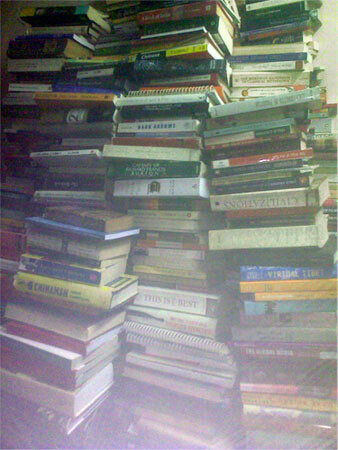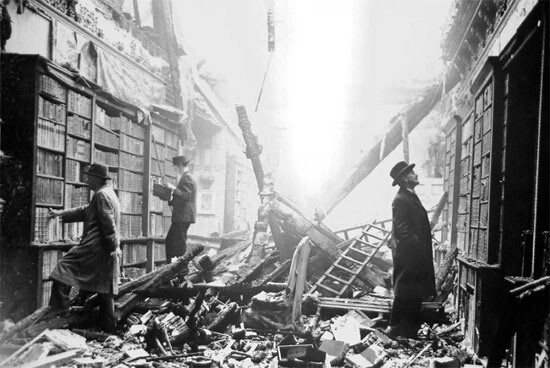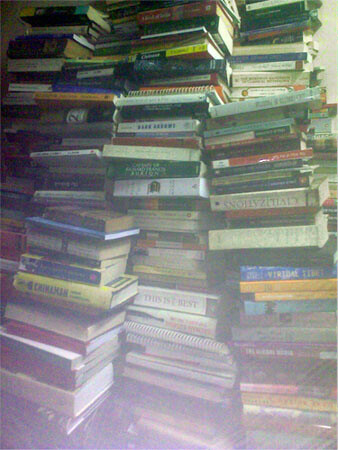Over the last few monsoons I lived with the dread that the rain would eventually find its ways through my leaky terrace roof and destroy my books. Last August my fears came true when I woke up in the middle of the night to see my room flooded and water leaking from the roof and through the walls. Much of the night was spent rescuing the books and shifting them to a dry room. While timing and speed were essential to the task at hand they were also the key hazards navigating a slippery floor with books perched till one’s neck. At the end of the rescue mission, I sat alone, exhausted amongst a mountain of books assessing the damage that had been done, but also having found books I had forgotten or had not seen in years; books which I had thought had been permanently borrowed by others or misplaced found their way back as I set many aside in a kind of ritual of renewed commitment.


Sorting the badly damaged from the mildly wet, I could not help but think about the fragile histories of books from the library of Alexandria to the great Florence flood of 1966. It may have seemed presumptuous to move from the precarity of one’s small library and collection to these larger events, but is there any other way in which one experiences earth-shattering events if not via a microcosmic filtering through one’s own experiences? I sent a distressed email to a friend Sandeep a committed bibliophile and book collector with a fantastic personal library, who had also been responsible for many of my new acquisitions. He wrote back on August 17, and I quote an extract of the email:
Dear Lawrence
I hope your books are fine. I feel for you very deeply, since my nightmares about the future all contain as a key image my books rotting away under a steady drip of grey water. Where was this leak, in the old house or in the new? I spent some time looking at the books themselves: many of them I greeted like old friends. I see you have Lewis Hyde’s Trickster Makes the World and Edward Rice’s Captain Sir Richard Francis Burton in the pile: both top-class books. (Burton is a bit of an obsession with me. The man did and saw everything there was to do and see, and thought about it all, and wrote it all down in a massive pile of notes and manuscripts. He squirrelled a fraction of his scholarship into the tremendous footnotes to the Thousand and One Nights, but most of it he could not publish without scandalising the Victorians, and then he died, and his widow made a bonfire in the backyard, and burnt everything because she disapproved of these products of a lifetime’s labors, and of a lifetime such as few have ever had, and no one can ever have again. I almost hope there is a special hell for Isabel Burton to burn in.)
Moving from one’s personal pile to the burning of the work of one of the greatest autodidacts of the nineteenth century and back it was strangely comforting to be reminded that libraries—the greatest of time machines invented—were testimonies to both the grandeur and the fragility of civilizations. Whenever I enter huge libraries it is with a tingling sense of excitement normally reserved for horror movies, but at the same time this same sense of awe is often accompanied by an almost debilitating sense of what it means to encounter finitude as it is dwarfed by centuries of words and scholarship. Yet strangely when I think of libraries it is rarely the New York public library that comes to mind even as I wish that we could have similar institutions in India. I think instead of much smaller collections—sometimes of institutions but often just those of friends and acquaintances. I enjoy browsing through people’s bookshelves, not just to discern their reading preferences or to discover for myself unknown treasures, but also to take delight in the local logic of their library, their spatial preferences and to understand the order of things not as a global knowledge project but as a personal, often quirky rationale.


Like romantic love, bibliophilia is perhaps shaped by one’s first love. The first library that I knew intimately was a little six by eight foot shop hidden in a by-lane off one of the busiest roads in Bangalore, Commercial street. From its name to what it contained, Mecca stores could well have been transported out of an Arabian nights tale. One side of the store was lined with plastic ware and kitchen utensils of every shape and size while the other wall was piled with books, comics, and magazines. From my eight-year-old perspective it seemed large enough to contain all the knowledge of the world. I earned a weekly stipend packing noodles for an hour every day after school in the home shop that my parents ran, which I used to either borrow or buy second hand books from the store. I was usually done with them by Sunday and would have them reread by Wednesday. The real anguish came in waiting from Wednesday to Friday for the next set. After finally acquiring a small collection of books and comics myself I decided—spurred on by a fatal combination of entrepreneurial enthusiasm and a pedantic desire to educate others—to start a small library myself. Packing my books into a small aluminum case and armed with a makeshift ledger, I went from house to house convincing children in the neighborhood to forgo twenty-five paisa in exchange for a book or comic with an additional caveat that they were not to share them with any of their friends. While the enterprise got off to a reasonable start it soon met its end when I realized that despite my instructions, my friends were generously sharing the comics after they were done with them, which thereby ended my biblioempire ambitions.
Over the past few years the explosion of ebook readers and consequent rise in the availability of pirated books have opened new worlds to my booklust. Library.nu, which began as gigapedia, suddenly made the idea of the universal library seem like reality. By the time it shut down in February 2012 the library had close to a million books and over half a million active users. Bibliophiles across the world were distraught when the site was shut down and if it were ever possible to experience what the burning of the library of Alexandria must have felt it was that collective ache of seeing the closure of library.nu.
What brings together something as monumental as the New York public library, a collective enterprise like library.nu and Mecca stores if not the word library? As spaces they may have little in common but as virtual spaces they speak as equals even if the scale of their imagination may differ. All of them partake of their share in the world of logotopias. In an exhibition designed to celebrate the place of the library in art, architecture and imagination the curator Sascha Hastings coined the term logotopia to designate “word places”—a happy coincidence of architecture and language.
There is however a risk of flattening the differences between these spaces by classifying them all under a single utopian ideal of the library. Imagination after all has a geography and physiology and requires our alertness to these distinctions. Lets think instead of an entire pantheon (both of spaces as well as practices) that we can designate as shadow libraries (or shadow logotopias if you like) which exist in the shadows cast by the long history of monumental libraries. While they are often dwarfed by the idea of the library, like the shadows cast by our bodies, sometimes these shadows surge ahead of the body.


At the heart of all libraries lies a myth—that of the burning of the library of Alexandria. No one knows what the library of Alexandria looked like or possesses an accurate list of its contents. What we have long known though is a sense of loss. But a loss of what? Of all the forms of knowledge in the world in a particular time. Because that was precisely what the library of Alexandria sought to collect under its roofs. It is believed that in order to succeed in assembling a universal library, King Ptolemy I wrote “to all the sovereigns and governors on earth” begging them to send to him every kind of book by every kind of author, “poets and prose-writers, rhetoricians and sophists, doctors and soothsayers, historians, and all others too.” The king’s scholars had calculated that five hundred thousand scrolls would be required if they were to collect in Alexandria “all the books of all the peoples of the world.”1
What was special about the Library of Alexandria was the fact that until then the libraries of the ancient world were either private collections of an individual or government storehouses where legal and literary documents were kept for official reference. By imagining a space where the public could have access to all the knowledge of the world, the library also expressed a new idea of the human itself. While the library of Alexandria is rightfully celebrated, what is often forgotten in the mourning of its demise is another library—one that existed in the shadows of the grand library but whose whereabouts ensured that it survived Caesar’s papyrus destroying flames.
According to the Sicilian historian Diodorus Siculus, writing in the first century BC, Alexandria boasted a second library, the so-called daughter library, intended for the use of scholars not affiliated with the Museion. It was situated in the south-western neighborhood of Alexandria, close to the temple of Serapis, and was stocked with duplicate copies of the Museion library’s holdings. This shadow library survived the fire that destroyed the primary library of Alexandria but has since been eclipsed by the latter’s myth.
Alberto Manguel says that if the library of Alexandria stood tall as an expression of universal ambitions, there is another structure that haunts our imagination: the tower of Babel. If the library attempted to conquer time, the tower sought to vanquish space. He says “The Tower of Babel in space and the Library of Alexandria in time are the twin symbols of these ambitions. In their shadow, my small library is a reminder of both impossible yearnings—the desire to contain all the tongues of Babel and the longing to possess all the volumes of Alexandria.”2 Writing about the two failed projects Manguel adds that when seen within the limiting frame of the real, the one exists only as nebulous reality and the other as an unsuccessful if ambitious real estate enterprise. But seen as myths, and in the imagination at night, the solidity of both buildings for him is unimpeachable.3
The utopian ideal of the universal library was more than a question of built up form or space or even the possibility of storing all of the knowledge of the world; its real aspiration was in the illusion of order that it could impose on a chaotic world where the lines drawn by a fine hairbrush distinguished the world of animals from men, fairies from ghosts, science from magic, and Europe from Japan. In some cases even after the physical structure that housed the books had crumbled and the books had been reduced to dust the ideal remained in the form of the order imagined for the library. One such residual evidence comes to us by way of the Pandectae—a comprehensive bibliography created by Conrad Gesner in 1545 when he feared that the Ottoman conquerors would destroy all the books in Europe. He created a bibliography from which the library could be built again—an all embracing index which contained a systematic organization of twenty principal groups with a matrix like structure that contained 30,000 concepts.4
It is not surprising that Alberto Manguel would attempt write a literary, historical and personal history of the library. As a seventeen-year-old man in Buenos Aries, Manguel read for the blind seer Jorge Luis Borges who once imagined in his appropriately named story—The Tower of Babel—paradise as a kind of library. Modifying his mentor’s statement in what can be understood as a gesture to the inevitable demands of the real and yet acknowledging the possible pleasures of living in shadows, Manguel asserts that sometimes paradise must adapt itself to suit circumstantial requirements. Similarly Jacques Rancière writing about the libraries of the working class in the eighteenth century tells us about Gauny a joiner and a boy in love with vagrancy and botany who decides to build a library for himself. For the sons of the poor proletarians living in Saint Marcel district, libraries were built only a page at a time. He learnt to read by tracing the pages on which his mother bought her lentils and would be disappointed whenever he came to the end of a page and the next page was not available, even though he urged his mother to buy her lentils from the same grocer. 5


Is the utopian ideal of the universal library as exemplified by the library of Alexandria or modernist pedagogic institutions of the twentieth century adequate to the task of describing the space of the shadow library, or do we need a different account of these other spaces? In an era of the ebook reader where the line between a book and a library is blurred, the very idea of a library is up for grabs. It has taken me well over two decades to build a collection of a few thousand books while around two hundred thousand books exist as bits and bytes on my computer. Admittedly hard drives crash and data is lost, but is that the same threat as those of rain or fire? Which then is my library and which its shadow? Or in the spirit of logotopias would it be more appropriate to ask the spatial question: where is the library?
If the possibility of having 200,000 books on one’s computer feels staggering here is an even more startling statistic. The Library of Congress which is the largest library in the world with holdings of approximately thirty million books, which would—if they were piled on the floor—cover 364 kilometers could potentially fit into an SD card. It is estimated that by 2030 an ordinary SD card will have the capacity of storing up to 64 TB and assuming each book were digitized at an average size of 1MB it would technically be possible to fit two Libraries of Congress in one’s pocket.
It sounds like science fiction, but isn’t it the case that much of the science fiction of a decade ago finds itself comfortably within the weaves of everyday life. How do we make sense of the future of the library? While it may be tempting to throw our hands up in boggled perplexity about what it means to be able to have thirty million books lets face it: the point of libraries have never been that you will finish what’s there. Anyone with even a modest book collection will testify to the impossibility of ever finishing their library and if anything at all the library stands precisely at the cusp of our finitude and our infinity. Perhaps that is what Borges—the consummate mixer of time and space—meant when he described paradise as a library, not as a spatial idea but a temporal one: that it was only within the confines of infinity that one imagine finishing reading one’s library. It would therefore be more interesting to think of the shadow library as a way of thinking about what it means to dwell in knowledge. While all our aspirations for a habitat should have a utopian element to them, lets face it, utopias have always been difficult spaces to live in.
In contrast to the idea of utopia is heterotopia—a term with its origins in medicine (referring to an organ of the body that had been dislodged from its usual space) and popularized by Michel Foucault both in terms of language as well as a spatial metaphor. If utopia exists as a nowhere or imaginary space with no connection to any existing social spaces, then heterotopias in contrast are realities that exist and are even foundational, but in which all other spaces are potentially inverted and contested. A mirror for instance is simultaneously a utopia (placeless place) even as it exists in reality. But from the standpoint of the mirror you discover your absence as well. Foucault remarks, “The mirror functions as a heterotopia in this respect: it makes this place that I occupy at the moment when I look at myself in the glass at once absolutely real, connected with all the space that surrounds it, and absolutely unreal, since in order to be perceived it has to pass through this virtual point which is over there.”6
In The Order of Things Foucault sought to investigate the conceptual space which makes the order of knowledge possible; in his famed reading of Borges’s Chinese encyclopedia he argues that the impossibility involved in the encyclopedia consists less in the fantastical status of the animals and their coexistence with real animals such as (d) sucking pigs and (e) sirens, but in where they coexist and what “transgresses the boundaries of all imagination, of all possible thought, is simply that alphabetical series (a, b, c, d) which links each of those categories to all the others.” 7 Heterotopias destabilize the ground from which we build order and in doing so reframe the very epistemic basis of how we know.
Foucault later developed a greater spatial understanding of heterotopias in which he uses specific examples such as the cemetery (at once the space of the familiar since everyone has someone in the cemetery and at the heart of the city but also over a period of time the other city, where each family possesses its dark resting place).8 Indeed, the paradox of heterotopias is that they are both separate from yet connected to all other spaces. This connectedness is precisely what builds contestation into heterotopias. Imaginary spaces such as utopias exist completely outside of order. Heteretopias by virtue of their connectedness become sites in which epistemes collide and overlap. They bring together heterogeneous collections of unusual things without allowing them a unity or order established through resemblance. Instead, their ordering is derived from a process of similitude that produces, in an almost magical, uncertain space, monstrous combinations that unsettle the flow of discourse.
If the utopian ideal of the library was to bring together everything that we know of the world then the length of its bookshelves was coterminous with the breadth of the world. But like its predecessors in Alexandria and Babel the project is destined to be incomplete haunted by what it necessarily leaves out and misses. The library as heterotopia reveals itself only through the interstices and lays bare the fiction of any possibility of a coherent ground on which a knowledge project can be built. Finally there is the question of where we stand once the grounds that we stand on itself has been dislodged. The answer from my first foray into the tiny six by eight foot Mecca store to the innumerable hours spent on library.nu remains the same: the heterotopic pleasure of our finite selves in infinity.
Esther Shipman and Sascha Hastings eds., Logotopia: The Library in Architecture Art and the Imagination, (Cambridge Galleries: Abc Art Books Canada, 2008).
Alberto Manguel, “My Library” in Hastings and Shipman eds. Logotopia, The Library in Art and Architecture and the Imagination, (Cambridge Galleries: ABC Art Books Canada, 2008).
Alberto Manguel, The Library at Night, (Yale University Press 2009).
Ray Hastings and Esther Shipman, eds. Logotopia: The Library in Architecture Art and the Imagination. Cambridge Galleries / ABC Art Books Canada, 2008.
Jacques Rancière, The Nights of Labour: The Workers’ Dream in Nineteenth Century France, (Philadelphia: Temple University Press, 1991).
Michel Foucault, “Different Spaces,” in Aesthetics, Method, Epistemology, ed. James D. Faubion (New York: The New Press, 1998), 179; For Foucault on language and heterotopias see The Order of Things: An Archaeology of the Human Sciences, (New York: Pantheon, 1970).
Ibid, xv.
In Foucault, “Different Spaces,” which was presented as a lecture to the Architecture Studies Circle in 1967, a few years after the writing of The Order of Things.
This essay is a part of a work I am doing for an exhibition curated by Raqs Media Collective, Sarai Reader 09. The show began on August 19, 2012, with a deceptively empty space containing only the proposal, with ideas for the artworks to come over a period of nine months. See https://sarai.net/sarai-reader-09-projections/.


